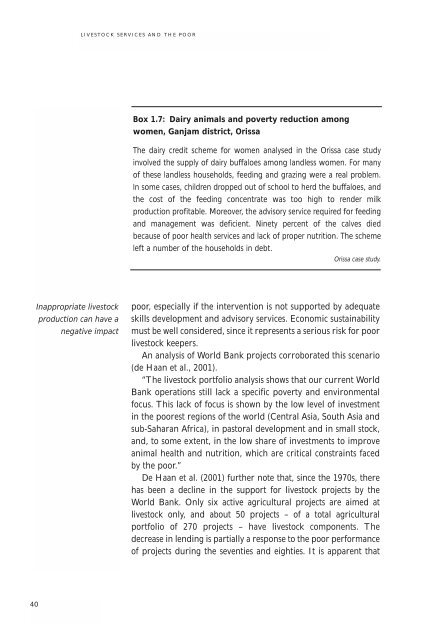Livestock Services and the Poor: A global initiative - IFAD
Livestock Services and the Poor: A global initiative - IFAD
Livestock Services and the Poor: A global initiative - IFAD
Create successful ePaper yourself
Turn your PDF publications into a flip-book with our unique Google optimized e-Paper software.
40<br />
Inappropriate livestock<br />
production can have a<br />
negative impact<br />
LIVESTOCK SERVICES AND THE POOR<br />
Box 1.7: Dairy animals <strong>and</strong> poverty reduction among<br />
women, Ganjam district, Orissa<br />
The dairy credit scheme for women analysed in <strong>the</strong> Orissa case study<br />
involved <strong>the</strong> supply of dairy buffaloes among l<strong>and</strong>less women. For many<br />
of <strong>the</strong>se l<strong>and</strong>less households, feeding <strong>and</strong> grazing were a real problem.<br />
In some cases, children dropped out of school to herd <strong>the</strong> buffaloes, <strong>and</strong><br />
<strong>the</strong> cost of <strong>the</strong> feeding concentrate was too high to render milk<br />
production profitable. Moreover, <strong>the</strong> advisory service required for feeding<br />
<strong>and</strong> management was deficient. Ninety percent of <strong>the</strong> calves died<br />
because of poor health services <strong>and</strong> lack of proper nutrition. The scheme<br />
left a number of <strong>the</strong> households in debt.<br />
Orissa case study.<br />
poor, especially if <strong>the</strong> intervention is not supported by adequate<br />
skills development <strong>and</strong> advisory services. Economic sustainability<br />
must be well considered, since it represents a serious risk for poor<br />
livestock keepers.<br />
An analysis of World Bank projects corroborated this scenario<br />
(de Haan et al., 2001).<br />
“The livestock portfolio analysis shows that our current World<br />
Bank operations still lack a specific poverty <strong>and</strong> environmental<br />
focus. This lack of focus is shown by <strong>the</strong> low level of investment<br />
in <strong>the</strong> poorest regions of <strong>the</strong> world (Central Asia, South Asia <strong>and</strong><br />
sub-Saharan Africa), in pastoral development <strong>and</strong> in small stock,<br />
<strong>and</strong>, to some extent, in <strong>the</strong> low share of investments to improve<br />
animal health <strong>and</strong> nutrition, which are critical constraints faced<br />
by <strong>the</strong> poor.”<br />
De Haan et al. (2001) fur<strong>the</strong>r note that, since <strong>the</strong> 1970s, <strong>the</strong>re<br />
has been a decline in <strong>the</strong> support for livestock projects by <strong>the</strong><br />
World Bank. Only six active agricultural projects are aimed at<br />
livestock only, <strong>and</strong> about 50 projects – of a total agricultural<br />
portfolio of 270 projects – have livestock components. The<br />
decrease in lending is partially a response to <strong>the</strong> poor performance<br />
of projects during <strong>the</strong> seventies <strong>and</strong> eighties. It is apparent that

















